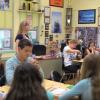The strategies that 12 states used to integrate performance assessment into state systems of assessment.

On the 1960s TV show "Gilligan's Island," one character, the Professor, was always designing ingenious approaches to improve life on the island. Why, the writer Anne Lamott has asked, didn't he just try to fix the boat? Teaching in America seems to suffer from a similar problem.
For the last decade, we have seen tremendous ingenuity in policy responses to the demand for teachers. Alternative routes to certification have opened a talent pool of midcareer recruits, while service corps like Teach For America have appealed to academically talented recent college graduates. These programs forge tighter connections with the personnel offices of high-need districts than universities typically have, creating a direct pipeline to hard-to-staff schools.
Meanwhile, growing numbers of critics have taken aim at traditional teacher preparation, often for legitimate reasons. Too many universities still offer fragmented coursework and haphazard clinical placements, disconnected from one another. Some critics have even called for an end to preservice preparation requirements, to be replaced by greater leeway for principals in hiring and the use of student test scores to weed out poor performers.
While the interest in teacher effectiveness is overdue, this approach does not offer a strategy to ensure that teachers will have opportunities to gain the skills they need. Nor does it protect the students-almost always minorities in low-income schools-who will be the victims of inadequately prepared novices in the years it takes for these teachers to prove their mettle, demonstrate their incompetence, or leave the field.
A Mathematica study released in February that compares the performance of teachers who entered the profession through different routes is bound to fuel the debate. Headlines from the study suggest that students of teachers from alternative routes who entered teaching before finishing their training performed no differently statistically than students of traditional-route teachers. ("Scores Unaffected by Teacher-Training Route," Feb. 25, 2009.)
The study discovered, as has previous research, that alternative-route recruits still in training were less effective than their traditional-route counterparts. But it also showed there were few differences for those who completed their coursework and stayed. As is generally the case, the members of the comparison group of "traditional" teachers in these hard-to-staff schools were themselves not highly selected, and had less preparation than most teachers nationwide. Consequently, the research does not offer much insight into the question of how better-prepared teachers perform in schools with more-selective hiring practices.
The real story, however, is that none of the teachers in these high-need schools did well by their students (see this review). The students of teachers from what the study called “low coursework” alternative programs actually declined in their reading and math achievement between fall and spring, while those taught by their traditional-route counterparts improved little. Students of teachers in the "high coursework" alternative programs, and those of their traditional-route counterparts, improved by only 1 and 2 percentile points, respectively-not nearly enough, given how far behind these students already were.
Put bluntly, no one who is serious about raising standards and closing achievement gaps can find these outcomes acceptable. It is time to put aside the tired debates over routes into teaching and focus on a clearer destination: substantially higher levels of teacher effectiveness, especially for those teaching the children who have been left farthest behind.
The answer is not to jettison teacher preparation, but to transform it, applying lessons from both traditional and alternative programs in new syntheses that substantially increase teachers' knowledge and skills. Our goal should be to encourage a race to the top in teaching quality, as other high-achieving nations have done, rather than the race to the bottom we currently seem determined to win.
Around the world, the highest-achieving nations have poured resources into teacher training and support over the last decade. Top-scoring Finland attributes its meteoric rise in achievement to a massive overhaul of teacher education it undertook two decades ago. As in other Scandinavian countries, all teachers there now receive three years of graduate-level preparation for teaching, completely at government expense, plus a living stipend. Their preparation includes training in a "model school" connected to the university, like the professional-development schools created by some successful U.S. programs, along with extensive pedagogical coursework, focused on using and conducting classroom research and meeting the needs of struggling learners.
Asian countries like Singapore also completely subsidize four years of undergraduate teacher education, including a salary while training. Unlike the United States, where teachers either go into debt to prepare for a profession that will pay them poorly or enter with little or no training-these countries invest in a uniformly well-prepared teaching force by recruiting top candidates and paying them to go to school. Slots in teacher-training programs are highly coveted, and shortages are unheard of. Teachers are paid well in relation to competing occupations, and salaries are equitable, sometimes with added incentives for harder-to-staff locations, so that all students receive well-trained teachers.
Rather than our current counterproductive contest, which pits insufficient models against each other, the United States needs to pursue a higher standard-in the caliber of candidates entering teaching, the quality of programs that prepare them, and society's support for teachers across their careers.
Fortunately, value-added studies conducted in several states have begun to identify the features of teacher-preparation programs whose graduates have strong positive impacts in the classroom. Effective programs build on solid content knowledge with pedagogical training that offers concrete, research-based tools for practice. This coursework is tightly linked to student-teaching with expert practitioners in carefully selected placements that reflect the kinds of settings in which candidates will later teach. Candidates are assessed on their performance, receive detailed feedback, and learn to evaluate their teaching in relation to student learning.
Key to these and other powerful programs, including the best of the new urban residency models, is strong clinical training-at least a full academic year of apprenticeship in the classrooms of excellent practitioners who model sophisticated strategies with students having a wide range of learning needs. This allows novices to integrate theory with practice as they develop the complex skills needed to plan and adapt instruction, assess student progress, diagnose learning difficulties, and meet student needs.
Many studies have demonstrated the large positive impact well-qualified teachers can have on student performance. A recent study of high school students in North Carolina found the effect of a well-qualified teacher-one who graduated from a competitive college, was prepared prior to entry and licensed in the field taught, experienced, and certified by the National Board for Professional Teaching Standards-to be larger than the effects of race and parent education combined. Another study of teachers, in New York City, found that improvements in a similar set of qualifications reduced the gap in achievement between schools serving the poorest and most affluent student bodies by 25 percent.
We need to develop policies that will provide these better-qualified teachers to all students. President Barack Obama's $6 billion teaching agenda includes service scholarships and investments in performance-based preparation, as well as mentoring and professional development in the context of new career ladders. His recently enacted stimulus package contains $100 million to support teacher residencies and other innovative preparation programs. The acid test for these investments will be whether they fundamentally transform the quality of teaching across all communities.
If real advances in student achievement are ever to be made, we must do a far better job of recruiting and preparing our teachers and organizing schools to support serious student learning. We must view teaching as a true profession, with clear standards of practice based on evidence, acquired systematically in settings that integrate research with practice. We must move beyond studying whether one weak approach to teacher training is no worse than another and focus on significantly increasing teacher capacity and effectiveness. Instead of tinkering at the margins, it's time to fix the boat.
Linda Darling-Hammond is the Charles E. Ducommun professor of education at Stanford University and a co-director of the Stanford Center for Opportunity Policy in Education. She led the education policy working group for the Obama transition team. David Haselkorn is a senior fellow and the director of policy studies at the Woodrow Wilson National Fellowship Foundation, in Princeton, N.J.
The strategies that 12 states used to integrate performance assessment into state systems of assessment.

Overview of the Instructional Leadership Corps (ILC). Hear from ILC participants and partners on how the ILC project is inspiring students and making an impact through collaboration.
A new book, Global Education Reform: How Privatization and Public Investment Influence Education Outcomes, provides a powerful analysis of these different ends of an ideological spectrum – from market-based experiments to strong state investments in public education.
Sign up for our free newsletter to learn about new SCOPE publications and upcoming events.
© Stanford University, Stanford, California 94305.

